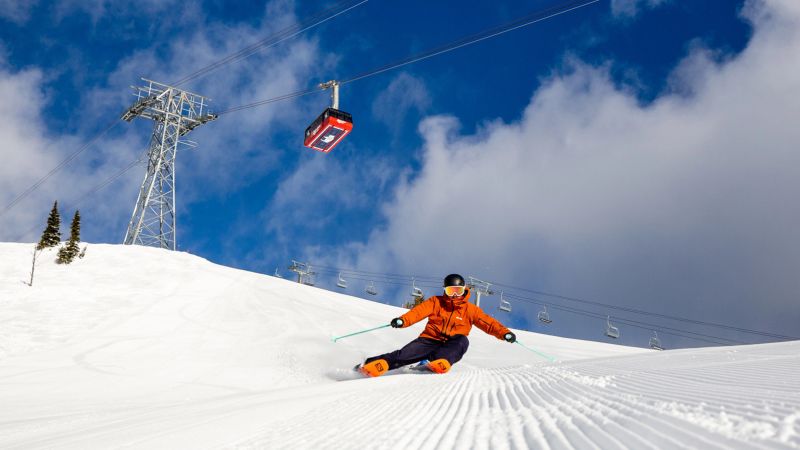
Ski resorts are starting to melt
Why do we need to do something? The Swiss ski resort Save Our Snow initiative aims to tackle the climate crisis globally, with a multi-year carbon footprint reduction plan
Ski lifts need power to keep turning all season, resort buildings need energy, snow groomers need fuel and guests need to travel, often creating large carbon footprints from long flights.
Planet-warming emissions are rising so quickly worldwide that experts at the World Meteorological Organization estimates that we could see another hottest year on record within the next five years, beating the previous record set in 2016.
Hundreds of millions of dollars are being spent on green initiatives, from small-scale in-resort activations to long-term systemic change, thanks to resorts across the globe who seem sincere about helping tackle the climate crisis.
A recent study from the French ski resorts of La Clusaz, Le Grand Bornand and Tignes, found that on average 52% of an individual’s carbon footprint for a day’s skiing came in travel to the resort.
The head of tourism for Courchevel, one of French skiing’s top resorts, said “it’s a worldwide responsibility to do something.”
We’ve seen climate change, we’ve seen different temperatures, we’ve seen snow that doesn’t come as often, and we’ve also seen new highs on top of the mountain. There is a lot of change and we have to take care of that.
“It’s not a marketing position, it’s a responsibility that everyone needs to have for the next generation. We don’t have skiing for the future if we don’t protect nature.
Save Our Snow claims that 58 of the 250 leading ski resorts are now powered by green energy, with 56 of them generating some or all of that.
“We have to run our lifts, we have to heat our hotels and restaurants and we have to make snow. In all of those applications you say, ‘How can we do those most efficiently?'”
The Colorado resort uses advocacy as its main weapon along with all the usual local eco best practices.
Holy Cross Energy, which serves the Aspen Skiing Company, is going to switch from coal to renewable energy in 15 years, thanks to a complex 15-year project that Schendler says will help achieve that goal.
It was difficult but it changed our competitors, according to Schendler. “The point is, that’s big-scale change and that’s not the kind of thing you typically hear sustainability executives talking about.”
Aspen Skiing and the Aspen Climate Change Initiative: The impact of ski resort carbon neutrality and energy production on ski tourism, restaurants, slope facilities and ski resorts
Aspen Skiing company spent $5.34 million in 2012 on a plant that converts methane from a coal mine into electricity, which has nearly repaid the original investment.
Aspen helped to develop theLeadership in Energy and Environmental Design scheme for green buildings in 1991 and is now developing all electric buildings alongside an array of solar projects to supplement its green energy supply.
Schendler, though, warns that carbon neutrality can sometimes be a red herring as paying for schemes to offset emissions doesn’t achieve systemic change.
The ski lifts, mountain restaurants and snow-making facilities in Lech and Zurs are all powered by 100% Austrian hydropower and supplemented by photovoltaic, solar and energy recovery systems.
“Systemic solutions are the way we need to deal with climate change, we need to get to net zero by 2050 or sooner, ideally,” said Dominic Winter of Protect Our Winters UK , part of the global climate change lobby group founded by American professional snowboarder Jeremy Jones in 2007.
The other significant elephant in the room when assessing the environmental impact of ski resorts is the huge carbon footprint of visitors to ski resorts, notably foreigners arriving by emission-heavy flights.
HFO fuel is 100% renewable and made from waste fat and vegetable oil, which reduces CO2 emissions by 90%.
The group has pledged to be carbon neutral by the end of the 20th century and is working with a French manufacturer to explore electric and hydrogen Groomers, which would result in a reduction of over 10% of its carbon emissions. The CDA will teach drivers and lift operators how to save money on fuel and energy.
The Swiss resort of Zermatt pays for more expensive sulfur-free “eco speed” diesel for its fleet of working machines, including 29 groomers, which adds about CHF 40,000 each year ($41,000) but generates 11% less carbon monoxide and reduces the concentration of hydrocarbons by 15%.
“We have the greenest cats available but it’s a niche technology so we’re a little bit at the mercy of manufacturers,” added Schendler. To play off of diesel is to move to electric or hydrogen. That technology will arrive, but not at a large scale.
Val d’Isère Téléf’egriques (Chambermont) – Snowmaking at a ski resort
The third pillar of ski resort operations is snowmaking, which is necessary to supplement nature’s contribution and ensure runs into resorts and other busy areas have ample coverage.
It works by spraying a high-pressure mist of water into cold air to freeze into snow crystals. An ice crystal can be formed more easily with adegradable nucleating agent or organic particle.
Val d’Isere’s renowned snowmaking factory is also pushing the boundaries and now uses half as much water to produce twice as much snow as it did 20 years ago, with no additives.
“This is an area that we have been looking into for several years now, and it requires real expertise,” says Aurelie Leveque, Operations Director for Val d’Isère Téléphériques.
The process does not require the use of chemical products or equipment, and the water that we use comes from a drainage basin that empties into the Isre River.
On an annual basis, snowmaking is 10% of total energy use. The total water use is a teeny portion of the watershed. It has gotten more efficient over the last 10 years because of the technology.
Schendler isn’t fond of snowmaking, but it’s part of the business and you have to do it as efficient as you can.
Courchevel – From ski resorts to mega resorts: Why do we have a choice? What we need to do now, and how we can change it
In Courchevel, there are more trees now than when the resort was first built in 1946, while Val d’Isere was recently awarded the French Flocon Vert sustainability certification, is making big strides in the conservation of endangered black grouse.
However, resort expansion and linking neighboring ski areas to form mega resorts has become a modern trend, motivated by commercialism but often highly controversial.
The long-mooted plan to connect Solden’s Otztal glacier to the Pitztal glacier , installing three new lifts, building restaurants and carving out a tunnel, threatens to change a pristine high alpine environment and its biodiversity forever, according to critics.
Are we winning? No. Schendler said that’s self-evident. We need to reverse global CO2 emissions and bend the curve down so we can do more to address climate change.
More than 100 percent of households and businesses have access to four biomass heating plants which save about eight million liters of heating oil or 24,000 tons of CO2 emissions annually.
Launch of Montagne, Ecology and Technology start-up contest worth 30,000 euros. The 2021 winner has developed pioneering 100% recyclable skis, saving 150,000 pairs of rental skis annually from the trash.
The new V-Cableway Eiger Express operates on a mixture of hydroelectricity and CO2-neutral thermal energy from a wood-fired heating plant that burns forest chips, sawmill residue and waste wood from the region. The new cableway technology ensures that there are fewer pylons.
A new 10-seater has solar panels to generate electricity all year around, while the heat from the lift’s motor will be recycled.
Why do Val d’Isere and Tignes have so much to offer? A case study in the South of the Matterhorn
Editor’s Note: Monthly Ticket is a CNN Travel series that spotlights some of the most fascinating topics in the travel world. We are exploring the people, places and journeys to make tourism more sustainable in February.
The infrastructure helping skiers dance in nature’s playground is costly to an environment already under pressure from a warming planet.
It grew out of a sleepy Savoie hamlet at the head of the Tarentaise valley, but now Val d’Isere and neighboring Tignes are leading the way in sustainability.
The pair have recently earned the prestigious Flocon Vert (green snowflake) label, which recognizes 20 sustainable development best practices, including energy conservation, recycling, local initiatives and biodiversity projects such as protecting black grouse in the adjacent Vanoise National Park.
It’s a step on the way to an all-electric or hydrogen-powered fleet. The resort operator Compagnie des Alpes pledges to be carbon neutral by the end of the century, with a target of 15 electric buses.
The historic resort at the foot of the Matterhorn has a strong eco flex – it’s long been car free, and visitors can reach the heart of the town by train, with connections to Zurich or Geneva airports.
Solar panels have been installed at the new 3S cableway Valley station, which will use less power than 35 households and save more than 2 metres of CO2 a year.
The building of the Matterhorn Glacier Paradise, which has views over 38 4,000 metres of peaks and fourteen glaciers, is powered by a photovoltaic system that can produce enough energy for its yearly heating, lighting and ventilation needs.
Source: https://www.cnn.com/travel/article/sustainable-ski-resorts-cmd/index.html
The Upper Lech resort: transforming into a ski resort for the world’s largest ski resort, and converting Pyha into the cleanest resort in the world
obsolete infrastructure, such as old lifts is removed and repaired by Zermatt. Cables are replaced every seven to 15 years and decommissioned cables are sent to Myanmar to be used in bridge building.
“Quality before quantity” has been Lech’s mantra since the 1960s, and the resort has retained its charm, agricultural heritage and Walser identity by strictly limiting development and allowing a maximum of 10,000 guest beds.
The exclusive enclave of Oberlech, perched on a sunny shelf above Lech, is traffic free thanks to an ingenious tunnel that whisks luggage, supplies and waste up and down from the hotels and chalets in electric vehicles while guests glide overhead in ski lifts.
A herd of Scottish Highland cattle which are grazed on steep slopes in the summer help to prevent the slide in the winter, while their meat is used in local gastronomy.
The resort, an intermediate haven allied to some of the world’s best terrain parks for air-addicted freestylers and boarders, has been fueled by Swiss hydropower since 2008.
But renewable energy only produces a quarter of the demands of the extended Laax-Flims-Falera-Trin-Sagogn region – with climate-damaging combustibles for heating and transport making up the bulk of the rest – and local environmental visionary Reto Fry wants to move from consumer to supplier by maximizing the potential of local wind, solar, hydro and biomass sources.
Adding solar panels, moving away from oil based heating, and promoting energy efficiency are all included in his plan.
The move to greener snow grooming vehicles and pre-building of the huge halfpipes and terrain park features has reduced the energy needed for artificial snow by 40%.
Far north, in the heart of Finnish Lapland, pint-sized Pyha has the stated mission of becoming the cleanest ski resort in the world – and it is well on the way after achieving carbon-neutral status in 2011, just ahead of sister resort Ruka.
It offsets the rest, for example, the fossil fuel damage caused by piste-preparation machines. But even that has been reduced by up to 90% since the introduction of renewable biodiesel in 2021, reducing greenhouse gas emissions by 600 tons per year, the equivalent of removing 230 petrol cars for one year, according to the resort.
The resort used wind power from Horse Butte wind farm in Idaho and two local hydro suppliers in Wyoming to achieve 100% green power.
The ski area, known for the quality of its snow, its challenging terrain such as Corbet’s Couloir and the characterful Teton Village base area, has pledged to put all development, including materials, through a review process to ensure environmental best practices.
Source: https://www.cnn.com/travel/article/sustainable-ski-resorts-cmd/index.html
Big Sky, Skiing and Eco-Aiming: Courchevel, a boutique resort in the Lone Peak mammoth
A big sky, skiing and eco ambitions. The Lone Peak mammoth in Montana receives an average of 400 inches of cold, dry northern Rockies powder across its 5,850 acres of skiable land, 300 runs and 39 lifts.
The resort, which was opened in 1973, claims to have been carbonfree by January 2021 because of the purchase of carbon credits.
Local schemes at Big Sky include guest carbon offsets, optimizing lodge heating, solar-powered operational elements, a transition to LED lighting and advanced snowmaking.
Courchevel is a designer chic ski area with over 600 kilometers of linked runs in the Les 3 Vallees.
The eco points lost by having the glitterati land at its airport on the slopes can be recovered by using 100% green energy for its lifts and snowmaking.
Numerous hillside reservoirs supply the required water, which is topped up seasonally, while the resort says there are more carbon-absorbing trees in the ski area now than when it was first created out of a remote farming settlement in 1946.
Courchevel wants to reduce traffic by encouraging visitors to park further down the valley in order to ride up in a renovated lift from Le Praz 1300.
It is also diligent in removing redundant lift infrastructure as upgrades are made, has launched an annual eco start-up prize for pioneering planet-saving projects such as recyclable skis, and is even hyper-aware of what its myriad Michelin-starred restaurants are serving their guests.
Customers should know we won’t supply cherries from Venezuela or strawberries from South Africa, we’ll give them the best produce of the region with a low impact of energy.
The biggest resort in Canada with 8,171 skiable acres, 35 lifts and 200 runs, it wears its impact lightly, as the winner of numerous sustainability awards.
The Fitzsimmons Creek hydro project, tapping the energy of the river tumbling down between Whistler and Blackcomb Mountain, creates enough electricity to power the lifts, operations facilities and snowmaking for the winter.
Vail resorts has a plan to achieve a zero energy and waste footprint by the year 2030. It is on track to hit its targets in waste management and forestry impact, according to its progress report.
The food and beverage department has been retro-fitted to reduce landfill waste 70% since 2000 and the snow guns have been switched to more energy efficient models.

